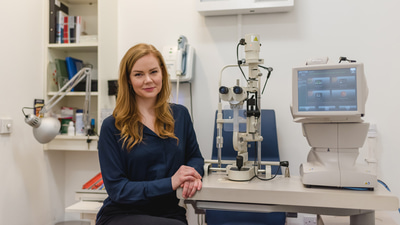- OT
- Life in practice
- Business management
- Communicating effectively with potential contact lens wearers
Practice team digest
Communicating effectively with potential contact lens wearers
With the whole practice team in mind, optometrist, owner of Hill Eyecare, and Johnson & Johnson Vision faculty member, Gemma Hill, answers: how do I communicate effectively with potential contact lens wearers?


Gemma Hill
28 March 2023
Many patients will benefit from the freedom of contact lens wear but be reticent to ask or try, while others may not yet even appreciate how much contact lenses could enhance their life. It is therefore important that the whole practice team is comfortable talking to patients about the different contact lens options available and are able to carefully manage any fears or misconceptions patients may have.
The contact lens conversation

For me, the key to successful contact lens conversations is to make personalised recommendations, allowing patients to see how contact lenses can benefit their life. This means taking the time to explore the patient’s lifestyle and visual needs. For example, if a patient has told me they enjoy running, I ask: “How do you get on wearing your glasses when running?” This open question gives the patient an opportunity to share their real-life experience with me. Then, where appropriate, this can be followed up with, “what difference would it make if you could be glasses-free when running?” Immediately, this allows the patient to see how contact lenses can benefit their life.
The dispense
Spectacle dispensing provides ample opportunity for dispensing opticians or optical assistants to introduce contact lenses to patients. Again, personalised recommendations are best here, with contact lenses offered as an additional option on top of glasses to support the patient’s lifestyle. In the same way that one pair of shoes will not take you from a walk in the hills to a night out, we shouldn’t expect one vision solution to suit every aspect of a patient’s life.With the cost-of-living pressure increasing, more patients may question the expense associated with contact lens wear. For potential daily disposable wearers, breaking it down to cost per wear can be really useful. Remember, for the price of a cup of coffee a day, the right contact lens could improve their quality of life.
It is important to allow the patient time to voice any specific worries they have about contact lens wear. If you actively listen and address these concerns empathetically, the patient will feel supported in their contact lens journey and are far more likely to have a positive attitude to beginning contact lens wear.
Potential new wearers will often worry about being able to apply and remove contact lenses. Make sure that plenty of time is allocated for application and removal training, and, if possible, provide a private space away from the shop floor for this. Providing the patient with educational video tools, such as those provided by JJV, ahead of training, can be really helpful for reassuring them that this is a skill that can be learnt and become second nature, just like riding a bike.
Remember, the patient contact lens journey does not end when the patient walks out with their first supply of lenses. Think about ways your practice can best support new wearers. An elegant solution is to have a staff member make a quick phone call during the trial period to see how the patient is finding their contact lenses and determine if a visit is required to iron out any issues. As a practitioner, this will help you problem solve before any dropouts occur.
Gemma’s top tips
- Ensure contact lenses are visible and are discussed across the whole patient journey
- Give personalised recommendations that suit the patient’s lifestyle
- Directly address any fears or misconceptions that patient may have.
Johnson & Johnson Vision (JJV) professional education and development manager for the UK & Ireland, Dr Rachel Hiscox, on why the whole team is key
Why is team training important when it comes to contact lenses? And how can JJV support practices in this?
Whilst the optometrist or contact lens optician may do the contact lens fitting, the whole practice team is crucial in supporting contact lens wearers on their journey. From conversations about how contact lenses can provide another useful and life-enhancing correction option during spectacle dispenses, through to excellent application and removal training and on-going patient support when the patient is becoming familiar with lens wear in their day-to-day life. Every member of the practice team is important in providing excellent patient experiences for all contact lens wearers, whether a new or established wearer.
JJV has a wide range of resources to support the practice team, from online learning and blended learning journeys, through to face-to-face or virtual educational sessions on a variety of different topics, led by our talented professional affairs consultant team. Our ACUVUE account managers are available to keep the practice team updated on the latest industry insights and product innovations. On top of this, we also have a wide range of CPD training, again available online or in-practice, and have a wealth of marketing resources enabling practices to reach out to their patients via their own websites or recalls. For further information, speak to your local ACUVUE account manager, visit the JJV website, or contact the customer services team on 0800 022 422.
Advertisement

Comments (0)
You must be logged in to join the discussion. Log in